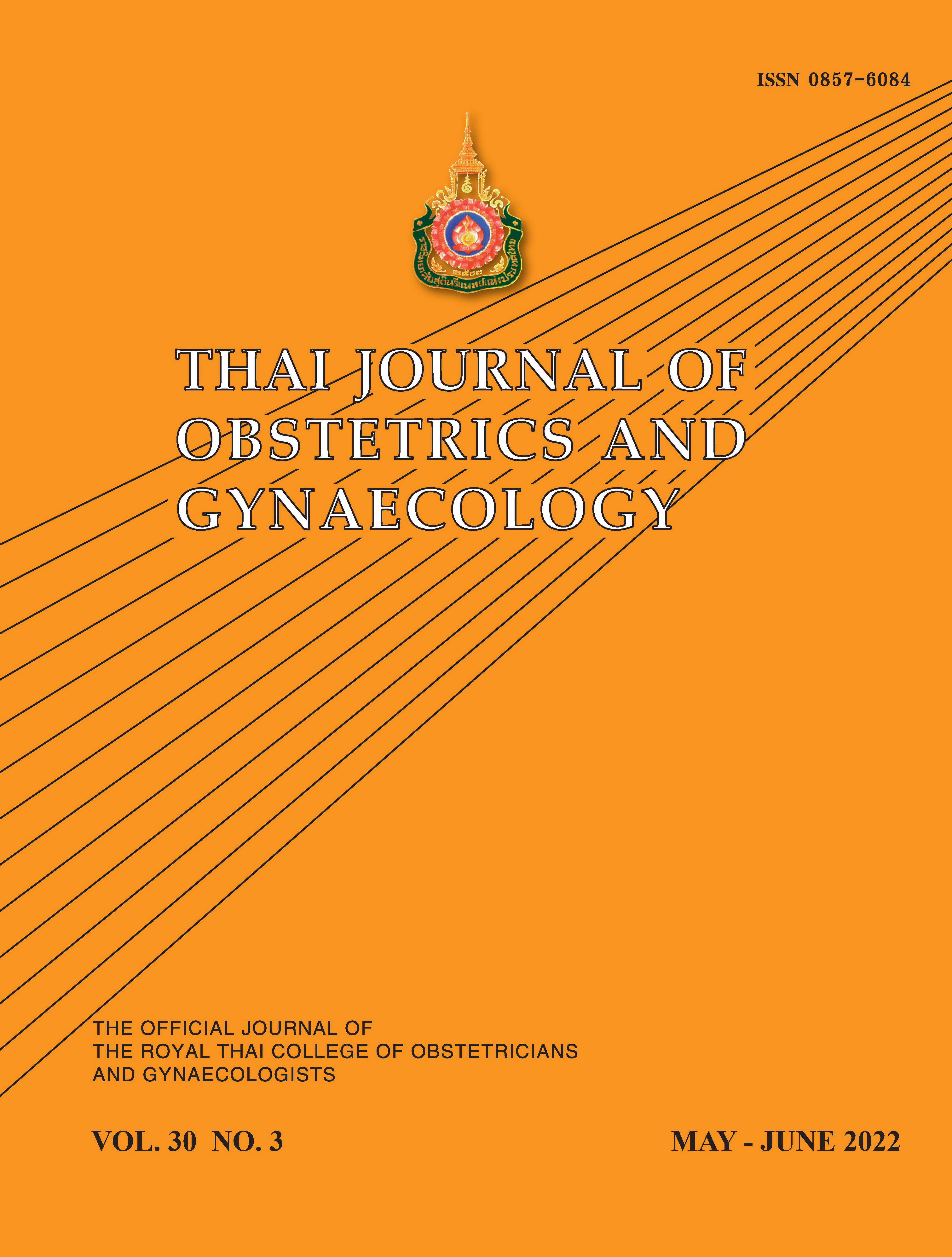Medical Abortion at Gestational Age ≤ 24 weeks at Songklanagarind Hospital
Main Article Content
Abstract
Objectives: To determine the success and complication rates of medical abortion at gestational age ≤ 24 weeks, and to identify their associated factors.
Materials and Methods: A retrospective study was conducted from January 2006 to December 2017. Medical records of pregnant women at gestational age ≤ 24 weeks, who were admitted for medical abortion, were reviewed. Spontaneous abortion was excluded. Multivariate logistic regression analysis was used to identify factors associated with success and complications. A p value of < 0.05 was considered statistically significant.
Results: A total of 717 cases were reviewed. Two medical regimens were used, including misoprostol alone (84.7%) and mifepristone-misoprostol (MM) (15.3%). The overall success rates in the first and second trimester were 65.8% and 79.3%. The highest success rate was observed in women at gestational age of ≤ 9 weeks, with the MM regimen (92.0%). The overall complication rate was 5.3%, including hemorrhage requiring blood transfusion (4.7%) and infection (0.6%). The complication rates in the first and second trimester were 2.5% and 5.6%, respectively. One factor associated with success in the first trimester was the drug regimen (MM); while that in the second trimester was maternal age. Multivariate analysis showed that factors associated with complications in the second trimester were multigravida and having an underlying disease.
Conclusion: Medical abortion at gestational age ≤ 24 weeks had low complications. Multigravida and having an underlying disease were factors associated with complications in the second trimester.
Article Details

This work is licensed under a Creative Commons Attribution-NonCommercial-NoDerivatives 4.0 International License.
References
Kulier R, Kapp N, Gülmezoglu AM, Hofmeyr GJ, Cheng L, Campana A. Medical methods for first trimester abortion. Cochrane Database Syst Rev 2011;(11):CD002855.
Baiju N, Acharya G, D’Antonio F, Berg RC. Effectiveness, safety and acceptability of self-assessment of the outcome of first-trimester medical abortion: a systematic review and meta-analysis. BJOG 2019;126:1536-44.
Tang OS, Ho PC. Medical abortion in the second trimester. Best Pract Res Clin Obstet Gynaecol 2002;16:237-46.
Shah D, Rijal P, Thakur A, Rai R. Mifepristone and misoprostol vs misoprostol alone in second trimester termination of pregnancy. J Nepal Med Assoc 2018;56:856-60.
Abubeker FA, Lavelanet A, Rodriguez MI, Kim C. Medical termination for pregnancy in early first trimester (≤ 63 days) using combination of mifepristone and misoprostol or misoprostol alone: a systematic review. BMC Womens Health 2020;20:142.
Meena SR. Comparative study of mifepristone with vaginal misoprostol for first trimester termination of pregnancy at different gestational ages. J Obstet Gynaecol India 2016;66:426-30.
Raymond EG, Trussell J, Polis CB. Cost-effectiveness of increased access to emergency contraceptive pills: probably not. Contraception 2013;87:504-8.
Lerma K, Shaw KA. Update on second trimester medical abortion. Curr Opin Obstet Gynecol 2017;29:413-8.
Fiala C, Cameron S, Bombas T, Parachini M, Agostini A, Lertxundi R, et al. Outcome of first trimester medical termination of pregnancy: definitions and management. Eur J Contracept Reprod Health Care 2018;23:451-7.
Carlsson I, Breding K, Larsson PG. Complications related to induced abortion: a combined retrospective and longitudinal follow-up study. BMC Womens Health 2018;18:158-66.
Heikinheimo O, Suhonen S, Haukkamaa M. One- and 2-day mifepristone-misoprostol intervals are both effective in medical termination of second-trimester pregnancy. Reprod Biomed Online 2004;8:236-9.
Morris JL, Winikoff B, Dabash R., Weeks A, Faundes A, Gemzell-Danielsson K, et al. FIGO’s updated recommendations for misoprostol used alone in gynecology and obstetrics. Int J Gynaecol Obstet 2017;138:363-6.
Kapp N, Eckersberger E, Lavelanet A, Rodriguez MI. Medical abortion in the late first trimester: a systematic review. Contraception 2019;99:77-86.
Dahiya K, Ahuja K, Dhingra A, Duhan N, Nanda S. Efficacy and safety of mifepristone and buccal misoprostol versus buccal misoprostol alone for medical abortion. Arch Gynecol Obstet 2012;285: 1055-8
Goldstone P, Walker C, Hawtin K. Efficacy and safety of mifepristone-buccal misoprostol for early medical abortion in an Australian clinical setting. Aust N Z J Obstet Gynaecol 2017;57:366-71.
Ireland LD, Gatter M, Chen AY. Medical compared with surgical abortion for effective pregnancy termination in the first trimester. Obstet Gynecol 2015;126:22-8.
Nissi R, Santala M, Immonen E, Talvensaari-Mattila A. Mifepristone and misoprostol is safe and effective method in the second-trimester pregnancy termination. Arch Gynecol Obstet 2016;294:1243-7.
Nigam A, Singh VK, Prakash A. Vaginal vs. oral misoprostol for mid-trimester abortion. Int J Gynaecol Obstet 2006;92:270-1.
Wong KS, Ngai CS, Wong AY, Tang LC, Ho PC. Vaginal misoprostol compared with vaginal gemeprost in termination of second trimester pregnancy. A randomized trial. Contraception 1998;58:207-10.
Wong KS, Ngai CS, Yeo EL, Tang LC, Ho PC. A comparison of two regimens of intravaginal misoprostol for termination of second trimester pregnancy: a randomized comparative trial. Hum Reprod 2000;15:709-12.
Pongsatha S, Tongsong T. Intravaginal misoprostol for pregnancy termination. Int J Gynaecol Obstet 2004;87:176-7.
Allen R, O’Brien BM. Uses of misoprostol in obstetrics and gynecology. Rev Obstet Gynecol 2009;2:159-68.
Haimov-Kochman R, Arbel R, Sciaky-Tamir Y, Brzezinski A, Laufer N, Yagel S. Risk factors for unsuccessful medical abortion with mifepristone and misoprostol. Acta Obstet Gynecol Scand 2007;86:462-6.
Bartley J, Tong S, Everington D, Baird DT. Parity is a major determinant of success rate in medical abortion: a retrospective analysis of 3161 consecutive cases of early medical abortion treated with reduced doses of mifepristone and vaginal gemeprost. Contraception 2000;62:297-303.


